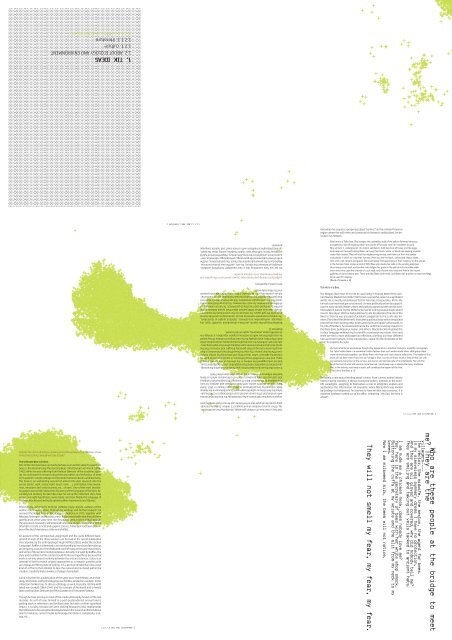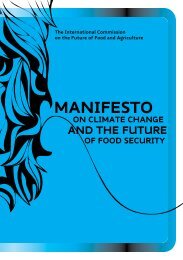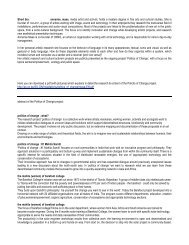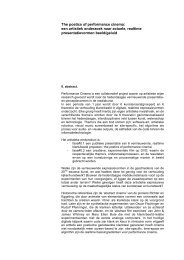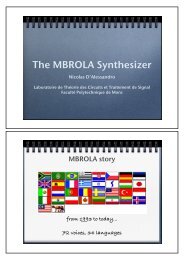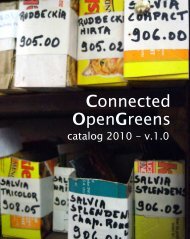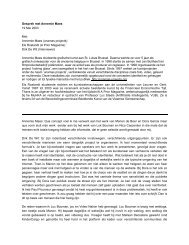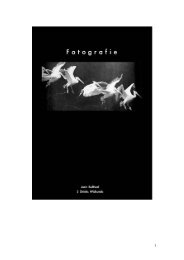They are the They will not smell my fear, my fear, my fear.
They are the They will not smell my fear, my fear, my fear.
They are the They will not smell my fear, my fear, my fear.
You also want an ePaper? Increase the reach of your titles
YUMPU automatically turns print PDFs into web optimized ePapers that Google loves.
1. TIK IDEAS<br />
1.2. ABOUT ECOLOGY AND ENVIRONMENT<br />
1.2.1. culture<br />
1.2.1.1. literature<br />
1.2.1.1.a. bees and literature<br />
1.2.1.1.a BEE AND LITERATURE 2<br />
And when he acquires a property (called “harmas”) in <strong>the</strong> remote Provence<br />
region where he <strong>will</strong> retire and continue his research undisturbed, he describes<br />
it as follows:<br />
Do we see here something like a new paradigm? Something aes<strong>the</strong>tic,<br />
emerging in between <strong>the</strong> literary, <strong>the</strong> arts, and <strong>the</strong> exact/natural sciences.<br />
Maybe due to <strong>the</strong> growing disciplinarity of each, <strong>the</strong> specializations, and <strong>the</strong><br />
birth of new (sub)sciences like psychology, anthropology, cybernetics, computer<br />
science, and o<strong>the</strong>rs in <strong>the</strong> long 20th century. Maybe <strong>the</strong> birth of hybrid<br />
expressive forms, with <strong>the</strong>ir own stylistic features, joining closer <strong>the</strong> poetical<br />
and philosophical traditions with a more exact and realistic language<br />
potential.<br />
Suddenly it is raining even harder now. So we can<strong>not</strong> turn to <strong>the</strong> garden and<br />
<strong>the</strong> bees <strong>the</strong>mselves. Let’s continue to write.<br />
Here comes a hypo<strong>the</strong>sis.<br />
Reading through <strong>the</strong> reports, we find a conventional ‘scientific’ style: dry<br />
language, unimaginative accurateness, statistical graphs as illustrations.<br />
The zealous taxonomist seemed to be just continuing his work like he had<br />
done with <strong>the</strong> gall wasps. For instance, for <strong>the</strong> second book he would personally<br />
interview almost 6000 women about <strong>the</strong>ir sexual behaviour. And<br />
just like he analyzed each insect by 26 parameters, he had an extensive list<br />
of different parameters for each interviewee. It is strange that <strong>the</strong>se works<br />
could ever become popular bestsellers. Still we believe <strong>the</strong>re is more to it<br />
than just <strong>the</strong> astonishing news about sexual orientation, pre- and extramarital<br />
sex, promiscuity, etc... But maybe, is <strong>the</strong>re a scientific style and a popular<br />
one? Do <strong>the</strong>y really exist?<br />
It seems that his work as a taxonomist, specifically investigating <strong>the</strong> ecological<br />
relations of organisms ra<strong>the</strong>r than adaptation and domestication issues,<br />
had <strong>not</strong> only triggered <strong>the</strong> interest in <strong>the</strong> diversity of one species, <strong>the</strong> gall<br />
wasp, and <strong>the</strong>ir diversified sexual behaviour. It would also lead to quite an<br />
innovating approach when researching and observing <strong>the</strong> similar behaviour<br />
of <strong>the</strong> human species. The reports showed that men and women in <strong>the</strong>ir<br />
sexuality were more equal than generally thought, and moreover that <strong>the</strong><br />
social and cultural environments were shaping ra<strong>the</strong>r than repressing sexuality<br />
for both. Definitely this was breaking many taboos and prejudices at <strong>the</strong><br />
end of <strong>the</strong> 1940s, and probably for <strong>the</strong> next 20 years to follow. Kinsey would<br />
be associated forever with his <strong>not</strong>orious popular reputation, a strange mix<br />
of scientific rigour, popularity, suspicion and scandal.<br />
[foot<strong>not</strong>e 1]<br />
40 years more than 300 insects a day. Interestingly <strong>the</strong> man became famous<br />
with ano<strong>the</strong>r part of his c<strong>are</strong>er and <strong>not</strong> as an entomologist. In 1948 he published<br />
<strong>the</strong> first of <strong>the</strong> so-called Kinsey reports Sexual Behavior in <strong>the</strong> Human<br />
Male, followed by Sexual Behavior in <strong>the</strong> Human Female in 1953. These<br />
were rigorous scientific works, with field interviews and statistics, for sure<br />
foundational to <strong>the</strong> modern field of sexology. In fundamentalist religious<br />
and cold-war USA <strong>the</strong>y provoked a storm of controversies which certainly<br />
had <strong>the</strong>ir influence on <strong>the</strong> so-called sexual revolution of <strong>the</strong> 1960s.<br />
York has a collection of 5 million gall wasps, donated by <strong>the</strong> late Alfred Kinsey.<br />
O<strong>the</strong>r sources mention an extravagant 7.5 million. Someone immediately<br />
started to calculate that in <strong>the</strong> former case he must have sampled over<br />
See here is a Tailor-bee. She scrapes <strong>the</strong> cobwebby stalk of <strong>the</strong> yellow-flowered centaury,<br />
and ga<strong>the</strong>rs a ball of wadding which she carries off proudly with her mandibles or jaws.<br />
She <strong>will</strong> turn it, underground, into cotton satchels to hold <strong>the</strong> store of honey and <strong>the</strong> eggs.<br />
And here <strong>are</strong> <strong>the</strong> Leaf-cutting Bees, carrying <strong>the</strong>ir black, white, or blood-red reaping brushes<br />
under <strong>the</strong>ir bodies. <strong>They</strong> <strong>will</strong> visit <strong>the</strong> neighbouring shrubs, and <strong>the</strong>re cut from <strong>the</strong> leaves<br />
oval pieces in which to wrap <strong>the</strong>ir harvest. Here too <strong>are</strong> <strong>the</strong> black, velvet-clad Mason-bees,<br />
who work with cement and gravel. We could easily find specimens of <strong>the</strong>ir masonry on <strong>the</strong> stones<br />
in <strong>the</strong> harmas. Next comes a kind of Wild Bee who stacks her cells in <strong>the</strong> winding staircase<br />
of an empty snail-shell; and ano<strong>the</strong>r who lodges her grubs in <strong>the</strong> pith of a dry bramble-stalk;<br />
and a third who uses <strong>the</strong> channel of a cut reed; and a fourth who lives rent-free in <strong>the</strong> vacant<br />
galleries of some Mason-bee. There <strong>are</strong> also Bees with horns, and Bees with brushes on <strong>the</strong>ir hind-legs,<br />
to be used for reaping.<br />
(Book of Insects p. 8)<br />
The Hero is a Bee.<br />
The Belgian (but most of his life he was living in France) Nobel Prize winner<br />
Maurice Maeterlinck (1862-1949), had a successful c<strong>are</strong>er as a symbolist<br />
writer. He is mostly remembered for <strong>the</strong> fairy-like L’oiseau bleu. All his life<br />
he had a controversial personal record - he was politically active by supporting<br />
<strong>the</strong> early socialist trade unions and publicly opposing both world wars.<br />
Interested in nature, by <strong>the</strong> 1920s he turned to writing several books about<br />
insects. Already in 1902 he had published La Vie des Abeilles (The Life of <strong>the</strong><br />
Bee). In 1926 he was accused of academic plagiarism for his La Vie des Termites<br />
(The Life of <strong>the</strong> White Ant). It became a political issue which would <strong>not</strong><br />
prevent him from writing o<strong>the</strong>r books about ants and spiders afterwards. In<br />
his Life of <strong>the</strong> Bees, he would summarize <strong>the</strong> until <strong>the</strong>n existing research in<br />
<strong>the</strong> field, done by Reaumur, Huber, and o<strong>the</strong>rs. Maeterlinck formulated this<br />
in clear language without much scientific or personal excursions. Here and<br />
<strong>the</strong>re we find a more philosophical reflection, pointing out how different<br />
bees <strong>are</strong> from humans. In <strong>the</strong> introduction, called ‘On <strong>the</strong> Threshold of <strong>the</strong><br />
Hive’, he explains his style:<br />
My facts shall be as accurate as though <strong>the</strong>y appe<strong>are</strong>d in a practical manual or scientific monograph,<br />
but I shall relate <strong>the</strong>m in a somewhat livelier fashion than such works would allow, shall group <strong>the</strong>m<br />
more harmoniously toge<strong>the</strong>r, and blend <strong>the</strong>m with freer and more mature reflections. The reader of this<br />
book <strong>will</strong> <strong>not</strong> learn <strong>the</strong>re-from how to manage a hive ; but he <strong>will</strong> know more or less all that can with<br />
any certainty be known of <strong>the</strong> curious, pro-found, and intimate side of its inhabitants. Nor <strong>will</strong> this<br />
be at <strong>the</strong> cost of what still remains to be learned. I shall pass over in silence <strong>the</strong> hoary traditions<br />
that, in <strong>the</strong> country and many a book, still constitute <strong>the</strong> legend of <strong>the</strong> hive.<br />
(The Life of <strong>the</strong> Bee, p. 5)<br />
Definitely a new way of writing about science, from science, within literary<br />
forms is being revealed. It shows clearly <strong>the</strong> writers’ interests in <strong>the</strong> scientific<br />
paradigms, assigning to <strong>the</strong>mselves a role to enlighten, explain and<br />
aes<strong>the</strong>ticize <strong>the</strong> information. An anecdote: when Maeterlinck was invited<br />
by Goldwyn to Hollywood, he seemed to have written two scenarios. It is<br />
reported Goldwyn rushed out of his office, screaming. “My God, <strong>the</strong> hero is<br />
a bee!”.<br />
1.2.1.1.a BEE AND LITERATURE 4<br />
Outside <strong>the</strong> rain is drizzling. Looking out of <strong>the</strong> window, <strong>the</strong> beehives show<br />
almost no activity. Should we take a look?<br />
The Ultimate Bee Scientist.<br />
One of <strong>the</strong> most sensitive accounts perhaps ever written about research on<br />
bees, is <strong>the</strong> mesmerizing The Dancing Bees (1953) by Karl von Frisch (1886-<br />
1962). While he was suffering from <strong>the</strong> Nazi takeover of <strong>the</strong> academic agenda,<br />
he continued his research about <strong>the</strong> perception and behaviour of bees<br />
in his p<strong>are</strong>nts’ remote cottage on <strong>the</strong> border between Austria and Germany.<br />
The book is an enchanting account of almost DIY-style research into <strong>the</strong><br />
senses (<strong>smell</strong>, sight, colour, light, touch, taste, ...), orientation, time aw<strong>are</strong>ness,<br />
emotions and consciousness, etc.. of bees. One of <strong>the</strong> most fascinating<br />
pages was written about <strong>the</strong> discovery of <strong>the</strong> language of <strong>the</strong> bees. Accurately<br />
but tenderly he describes how he set up <strong>the</strong> initial test sites, how<br />
wrong and right hypo<strong>the</strong>ses were made, and how finally <strong>the</strong> language of<br />
<strong>the</strong> bees was discovered by deciphering <strong>the</strong>ir movements and ‘dances’.<br />
Interestingly, von Frisch’s writings combine many stylistic features of <strong>the</strong><br />
authors mentioned before. Through his writings and fur<strong>the</strong>r research, he<br />
received <strong>the</strong> Nobel Prize in Physiology or Medicine in 1973, toge<strong>the</strong>r with<br />
Nikolaas Tinbergen and Konrad Lorenz. It was remarkable that <strong>the</strong>y all three<br />
got this prize at <strong>the</strong> same time. Von Frisch had been a victim of Nazi policies<br />
(he was also 1/4 Jewish), while Konrad Lorenz had been a contributor to <strong>the</strong><br />
attempt to create a racial and eugenic science. Tinbergen had been a member<br />
of <strong>the</strong> Dutch resistance at <strong>the</strong> end of WW2.<br />
An account of this controversial assignment and <strong>the</strong> quite different background<br />
of each of <strong>the</strong> three winners can be read in <strong>the</strong> recent publication<br />
Insectopedia, by <strong>the</strong> anthropologist Hugh Raffles (2010), under <strong>the</strong> section<br />
‘Language’. Raffles is interested in our relationship to insects and provides us<br />
an intriguing account of <strong>the</strong> dedicated work of many artists and researchers,<br />
and some of <strong>the</strong> writers mentioned above. Actually, <strong>the</strong> work by Raffles, <strong>the</strong><br />
style and treatment of <strong>the</strong> content could fit into our hypo<strong>the</strong>sis because <strong>the</strong><br />
work is <strong>not</strong> only about creativity between <strong>the</strong> arts and sciences, it also is an<br />
attempt in itself to match original approaches to a research question with<br />
an original and fitting style of writing. It is a perfect introduction into a new<br />
kind of art forms that attempt to fuse <strong>the</strong> natural and nurtured within <strong>the</strong><br />
creative; creativity that provokes a change of paradigm.<br />
Lured in by <strong>the</strong> title, a publication of <strong>the</strong> same year, Insect Media: an Archaeology<br />
of Animals and Technology by Jussi Parikka, landed on our desk. In this<br />
collection Parikka tries to discuss ethology as well, basically starting with<br />
Jakob von Uexküll (1864-1944) and his concepts of Merkwelt and Umwelt,<br />
later used by Gilles Deleuze and Félix Guattari in A Thousand Plateaus.<br />
Though he tries to bring in most of <strong>the</strong> media philosophy heroes of <strong>the</strong> last<br />
decades, he sort of loses himself in a post-postmodernist account and is<br />
getting stuck in references and brilliant ideas but with a ra<strong>the</strong>r superficial<br />
impact. It is a pity, because we were looking forward to new relationships<br />
that still seem to be unexplored today between <strong>the</strong> issues mentioned above<br />
and, for instance, current media technology, biorobotics, complexity, ecology,<br />
etc...<br />
1.2.1.1.a BEE AND LITERATURE 6<br />
<strong>They</strong> <strong>will</strong> <strong>not</strong> <strong>smell</strong> <strong>my</strong> <strong>fear</strong>, <strong>my</strong> <strong>fear</strong>, <strong>my</strong> <strong>fear</strong>.<br />
I am nude as a chicken neck, does nobody love me?<br />
Yes, here is <strong>the</strong> secretary of bees with her white shop smock,<br />
Buttoning <strong>the</strong> cuffs at <strong>my</strong> wrists and <strong>the</strong> slit from <strong>my</strong> neck to <strong>my</strong><br />
knees.<br />
Now I am milkweed silk, <strong>the</strong> bees <strong>will</strong> <strong>not</strong> <strong>not</strong>ice.<br />
Who <strong>are</strong> <strong>the</strong>se people at <strong>the</strong> bridge to meet<br />
me? <strong>They</strong> <strong>are</strong> <strong>the</strong><br />
villagers----<br />
The rector, <strong>the</strong> midwife, <strong>the</strong> sexton, <strong>the</strong> agent for bees.<br />
In <strong>my</strong> sleeveless summery dress I have no protection,<br />
And <strong>the</strong>y <strong>are</strong> all gloved and covered, why did nobody tell me?<br />
<strong>They</strong> <strong>are</strong> smiling and taking out veils tacked to ancient hats.
My God,<br />
<strong>the</strong> hero is<br />
a<br />
bee!<br />
Hidden lives and o<strong>the</strong>r professions by sex workers, anthropologists,<br />
historians, journalists and writers. About new artistic paradigms, or<br />
(<strong>not</strong>) just about bees and literature.<br />
WRITING AT THE THRESHOLD OF THE HIVE<br />
Writing Observations.<br />
Browsing through history and writing seems to support <strong>the</strong> wild hypo<strong>the</strong>sis.<br />
From recent history, <strong>the</strong> best known writer - increasingly popular in current<br />
new New Age times - is definitely Jean Henri Fabre (1823-1915).<br />
Today we planned to extract honey, but after a couple of days with moderate<br />
summer wea<strong>the</strong>r, it is suddenly raining continuously with heavy wind<br />
blasts now and <strong>the</strong>n.<br />
When relying on natural events and phenomena, one can never predict<br />
how and when things <strong>will</strong> happen. So far <strong>not</strong>hing new, since Henri Bergson<br />
already dedicated almost his whole philosophy to that, and even <strong>the</strong> most<br />
popular book on new science, chaos and complexity <strong>will</strong> tell you <strong>the</strong> same.<br />
But still we were counting on working with <strong>the</strong> beehives today... So, let’s sit<br />
down and sublimate our position: we <strong>will</strong> write and we want to write about<br />
writing and bees. Like, who was doing this, and why, and how?<br />
First of all, we won’t bo<strong>the</strong>r you with a full overview of who ever mentioned<br />
a bee in literature since antiquity. Besides, in 2001 Cristopher Hollingsworth<br />
published <strong>the</strong> remarkable literary study The Insect Metaphor in Literature.<br />
There, he explores from old Greek times to former postmodernism how famous<br />
authors like Homer (<strong>the</strong> wild bees), Virgil (<strong>the</strong> domestication), Dante<br />
(ascent to heaven), Milton (<strong>the</strong> fallen angels) to Conrad, Wells, Huxley, Sartre,<br />
Delillo and many more, were treating <strong>the</strong> idea of bees and more specifically<br />
<strong>the</strong> hive within <strong>the</strong>ir works. It is an outstanding overview of evolutionary<br />
stylistics, exploring relevant analogies and metaphors, highlighting special<br />
meanings and unique literary functions. Here <strong>are</strong> some lines from John Milton’s<br />
Paradise Lost (1667)<br />
Thick swarmed, both on <strong>the</strong> ground and in <strong>the</strong> air,<br />
Brushed with <strong>the</strong> hiss of rustling wings. As bees<br />
In spring-time, when <strong>the</strong> Sun with Taurus rides.<br />
The Anthropomorphic Metaphors.<br />
So now we had an autodidactic scientist-teacher, and a renowned writer.<br />
Ano<strong>the</strong>r crossover historian, writer and activist avant la lettre is, for sure, <strong>the</strong><br />
Dutch/English Bernard Mandeville (1670-1733). He started with translating<br />
some of Aesop’s fables, for instance ‘The Wasps and <strong>the</strong> Bees’. He <strong>the</strong>n published<br />
a strange combination of texts, called The Fable of <strong>the</strong> Bees (1714). It<br />
starts with <strong>the</strong> poem/fable ‘The Grumbling Hive: or, Knaves turn’d Honest’<br />
from 1705, adding a discussion in prose and some essays to it. As late as 1732<br />
he wrote a second series of comments.<br />
The Fable of <strong>the</strong> Bees combines a number of socio-political, religious and<br />
economic ideas that caused a lot of offense in England at <strong>the</strong> time. It uses<br />
<strong>the</strong> fable of <strong>the</strong> hive as a starting metaphor for an economic <strong>the</strong>ory that<br />
later would influence Adam Smith. In <strong>the</strong> poem a bee community is trying<br />
to achieve honesty and virtue through cooperation. But, <strong>the</strong>y lose <strong>the</strong> hive,<br />
suggesting that personal luxury and consumption benefits <strong>the</strong> community<br />
more than for instance common savings. He also disagreed on <strong>the</strong> fact that<br />
virtue would be added by education, observing that evil existed as much<br />
among <strong>the</strong> rich and educated, who <strong>are</strong> even more crafty. The texts <strong>are</strong> written<br />
in a pamphlet-like style with a very direct and open opinion. In <strong>the</strong>se<br />
older works <strong>the</strong> aes<strong>the</strong>tic programme seems to be missing. He defends his<br />
opinions. The hive is a mere metaphor for society.<br />
The first historian who would attempt to embellish science would probably<br />
be Jules Michelet (1798-1874). He published a first successful edition,<br />
L’Oiseau (1856), but <strong>the</strong>n wrote a dull and naive, sometimes very inaccurate<br />
and superficial work L’insecte (1857). His motives <strong>are</strong> inspired by <strong>the</strong> wish to<br />
write a poetry of science, by adding poetry and philosophy to science. A noble<br />
initiative but exaggerated metaphoric and bombastic, and for that reason<br />
almost unreadable now. How different from <strong>the</strong> subtle Fabre, <strong>the</strong> skillful<br />
Maeterlinck and <strong>the</strong> earlier impassioned Mandeville:<br />
The bee and <strong>the</strong> ant reveal to us <strong>the</strong> lofty harmony of <strong>the</strong> insect. Both, in <strong>the</strong>ir high intelligence,<br />
<strong>are</strong> of superior rank as artists, architects, and <strong>the</strong> like. The bee is more, a geometer; <strong>the</strong> ant is<br />
before all remark-able as an educator. The ant is frankly and strongly republican, having no need<br />
of a living and visible symbol of <strong>the</strong> community, lightly esteeming and governing with sufficient<br />
rudeness <strong>the</strong> soft and feeble females who perpetuate <strong>the</strong> race. The bee, on <strong>the</strong> o<strong>the</strong>r hand, more tender<br />
app<strong>are</strong>ntly, or less reasoning and more imaginative, finds a moral support in <strong>the</strong> worship of <strong>the</strong> common<br />
mo<strong>the</strong>r. For her community of virgins it is, so to speak, a religion of love. Among both <strong>the</strong> ants and<br />
bees maternity is <strong>the</strong> social principle but fraternity also takes root, nourishes, and springs to a<br />
glorious stature.<br />
(The Insect p. 335)<br />
The Dung-beetle, sated with days, becomes a patriarch and really deserves to do in consideration<br />
of <strong>the</strong> services rendered.There is a general hygiene that calls for <strong>the</strong> disappearance, in <strong>the</strong> shortest<br />
possible time, of every putrid thing. Paris has <strong>not</strong> yet solved <strong>the</strong> formidable problem of her refuse,<br />
which sooner or later <strong>will</strong> become a question of life or death for <strong>the</strong> monstrous city.<br />
One asks one’s self whe<strong>the</strong>r <strong>the</strong> centre of light be <strong>not</strong> doomed to be extinguished one day<br />
in <strong>the</strong> reeking exhalations of a soil saturated with rottenness. What this agglomeration of millions<br />
of men can<strong>not</strong> obtain, with all its treasures of wealth and talent, <strong>the</strong> smallest hamlet possesses<br />
without going to any expense or even troubling to think about it. Nature, so lavish of her c<strong>are</strong>s<br />
in respect of rural health, is indifferent to <strong>the</strong> welf<strong>are</strong> of cities, if <strong>not</strong> actively hostile to it.<br />
She has created for <strong>the</strong> fields two classes of scavengers, whom <strong>not</strong>hing wearies, whom <strong>not</strong>hing repels...<br />
(The Life and Love of <strong>the</strong> Insect p. 113)<br />
Interestingly, Hollingsworth analyzes <strong>the</strong> <strong>the</strong>me across history as an active<br />
rhetorical medium, a visual language tool bringing out different attitudes<br />
about ‘o<strong>the</strong>rness’ and <strong>the</strong> position of <strong>the</strong> (writer as) observer. Of course<br />
<strong>the</strong> hive represents mostly <strong>the</strong> relationship between individual and whole<br />
within <strong>the</strong> historical contexts of <strong>the</strong> prevailing social order and ideal state<br />
models, <strong>the</strong> hive being <strong>the</strong> dramatic form that symbolizes <strong>the</strong> differences<br />
and analogies. Ok-ok, I guess only a few of you reading out <strong>the</strong>re <strong>will</strong> still be<br />
interested by now.<br />
He definitely is no Darwin, investigating <strong>the</strong> hexagonal shapes of <strong>the</strong> honeycomb,<br />
fruitlessly trying to find <strong>the</strong> answer where to place nature’s instinct vs.<br />
intelligence. No big research agenda for Fabre. He is just looking at insects,<br />
trying to find out what <strong>the</strong>y <strong>are</strong> doing, building a narrative and explaining.<br />
Without decoration, except for <strong>the</strong> writer/observer, people seem to be absent..<br />
Here is when he finally talks about Paris:<br />
And soon <strong>the</strong> wea<strong>the</strong>r <strong>will</strong> be better anyway, and <strong>the</strong>n we can stop writing<br />
to make honey anyway. But in <strong>the</strong> meantime...<br />
Definitely both a teacher and writer, and an amazing autodidact in entomology,<br />
he became famous for his works on insects. Darwin would call him “<strong>the</strong><br />
inimitable observer”, though Fabre rejected evolution in favour of creationism,<br />
<strong>not</strong> in <strong>the</strong> biblical sense but ra<strong>the</strong>r because he simply mistrusted systems<br />
and big <strong>the</strong>ories. Reading through ‘Les Insectes’ and ‘Souvenirs entomologiques’<br />
one encounters a special style: a perfectly balanced, very clear<br />
language in-between accuracy and lyrics. Here no difficult scientific terms,<br />
no dramatic rhetorics ei<strong>the</strong>r. His accounts of bees and wasps, spiders and<br />
ants, <strong>are</strong> a questioning observation of <strong>the</strong> species within <strong>the</strong>ir natural environment,<br />
related sometimes to a story on how he found it (on a walk, on a<br />
school trip, ..).<br />
Wasps, Human Sex, and <strong>the</strong> difference.<br />
Lately, we came across an astonishing fact that immediately was met with a<br />
lot of scepticism. Somehow <strong>the</strong> American Museum of Natural History in New<br />
Is this still reflected nowadays on one hand in <strong>the</strong> bulk of popular scientific<br />
writing, some ghostwriting for scientists and on <strong>the</strong> o<strong>the</strong>r hand in <strong>the</strong> writ<br />
ing of horoscopes and gardening articles, books for TV cooks, or travel diaries?<br />
Maybe we don’t have to see this - from within literature itself - as a popular<br />
“divertissement” or escape strategy for <strong>not</strong> having to write <strong>the</strong> “true”<br />
great works... but ra<strong>the</strong>r as an experiment by <strong>the</strong> writer, making a new genre,<br />
a new textual expressivity, like sonification in music and visualization in<br />
movies and interactives. Playing with scientific data: interdisciplinary, multimodal,<br />
ano<strong>the</strong>r content than expected, ano<strong>the</strong>r imagination.<br />
1.2.1.1.a BEE AND LITERATURE 1<br />
1.2.1.1.a BEE AND LITERATURE 3<br />
1.2.1.1.a BEE AND LITERATURE 5<br />
Foot<strong>not</strong>e 1.<br />
Even Cole Porter would jump on <strong>the</strong> hype in <strong>the</strong> song ‘Too Darn Hot’ for <strong>the</strong><br />
musical ‘Kiss Me Kate’ (1948):<br />
According to <strong>the</strong> Kinsey report ev’ry average man you know<br />
much prefers to play his favorite sport when <strong>the</strong> temperature is low<br />
but when <strong>the</strong> <strong>the</strong>rmometer goes way up and <strong>the</strong> wea<strong>the</strong>r is sizzling hot<br />
Mister GOB for his squab, a marine for his queen, a G.I. for his cutie-pie is <strong>not</strong><br />
Cause it’s too too too darn hot, It’s too darn hot, It’s too darn hot<br />
Foot<strong>not</strong>e 2.<br />
For <strong>the</strong> complete sequence:<br />
http://www.scribd.com/doc/16664854/Bee-Poems-by-Sylvia-Plath<br />
Unto Today.<br />
Maybe <strong>the</strong>re is more around, and this is only a modest attempt to see what<br />
is to be learned from more than a century of interdisciplinarity and literature.<br />
As we mentioned above, speech and language, toge<strong>the</strong>r with for instance<br />
sonification and visualization, could yield an original and combined<br />
contribution to <strong>the</strong> arts. Provided it develops <strong>the</strong> appropriate tools, communication<br />
styles, open and diverse forms with original points of view. The<br />
different things that really make a difference, and <strong>not</strong> only promise to. But,<br />
every hypo<strong>the</strong>sis here has to remain a little utopia too. The hope is that more<br />
original works <strong>will</strong> emerge, and new genres <strong>will</strong> develop before <strong>the</strong>y can<br />
be pinpointed and attached to norms, only to evolve into a creative <strong>my</strong>riad<br />
of possibilities. Contradictions and differences, dissonance and noise, new<br />
patterns and structures, new languages... But definitely, <strong>the</strong> experimental<br />
exploration of a new artistic activity, related to scientific paradigms can be<br />
realized with more verve than we hear, see, and read nowadays.<br />
Back to some fiction. In 2009 <strong>the</strong> Canadian author Marg<strong>are</strong>t Atwood published<br />
The Year of <strong>the</strong> Flood. It is an apocalyptic and yet hopeful chaotic story<br />
about ecosects, posthuman society, genetic technology, or whatever is now<br />
at hand that <strong>will</strong> run out of hand. The Gardeners <strong>are</strong> central to <strong>the</strong> events.<br />
And <strong>the</strong> bees.<br />
Suddenly jumps up and goes to <strong>the</strong> window. ‘Ah, reminds me of <strong>my</strong> work<br />
today’ ... ‘Yes! The rain has stopped, have to go’.. ‘So, bye, and better read <strong>the</strong><br />
book when you have time’ ... ‘Really have to go now, it is getting dry outside!’<br />
... ‘Can<strong>not</strong> spoil <strong>the</strong> fun by telling you <strong>the</strong> end of <strong>the</strong> story anyway’ ...<br />
‘Ciao’... (standing in front of <strong>the</strong> window) ‘Euh... oh no, now it is getting dark,<br />
so no chance today to open <strong>the</strong> hives and centrifuge <strong>the</strong> honey’ ... ‘Damn!’...<br />
goes back to <strong>the</strong> desk and sits down...<br />
Ok, I am back, so let’s end in beauty. Let’s sing a last song before we part. And<br />
who better to voice it than <strong>the</strong> distinctive Sylvia Plath, who wrote 5 poems<br />
shortly before her tragic suicide, dealing with bees, o<strong>the</strong>r people, her own<br />
<strong>fear</strong>s and vulnerabilities,... All of a fragile beauty.<br />
From <strong>the</strong> poem THE BEE MEETING [Foot<strong>not</strong>e 2]:<br />
Who <strong>are</strong> <strong>the</strong>se people at <strong>the</strong> bridge to meet me? <strong>They</strong> <strong>are</strong> <strong>the</strong><br />
villagers----<br />
The rector, <strong>the</strong> midwife, <strong>the</strong> sexton, <strong>the</strong> agent for bees.<br />
In <strong>my</strong> sleeveless summery dress I have no protection,<br />
And <strong>the</strong>y <strong>are</strong> all gloved and covered, why did nobody tell me?<br />
<strong>They</strong> <strong>are</strong> smiling and taking out veils tacked to ancient hats.<br />
I am nude as a chicken neck, does nobody love me?<br />
Yes, here is <strong>the</strong> secretary of bees with her white shop smock,<br />
Buttoning <strong>the</strong> cuffs at <strong>my</strong> wrists and <strong>the</strong> slit from <strong>my</strong> neck to <strong>my</strong><br />
knees.<br />
Now I am milkweed silk, <strong>the</strong> bees <strong>will</strong> <strong>not</strong> <strong>not</strong>ice.<br />
<strong>They</strong> <strong>will</strong> <strong>not</strong> <strong>smell</strong> <strong>my</strong> <strong>fear</strong>, <strong>my</strong> <strong>fear</strong>, <strong>my</strong> <strong>fear</strong>.<br />
1.2.1.1.a BEE AND LITERATURE 8<br />
1.2.1.1.a BEE AND LITERATURE 7


